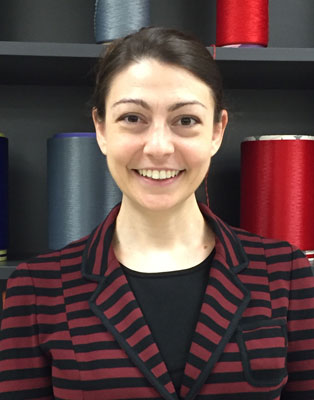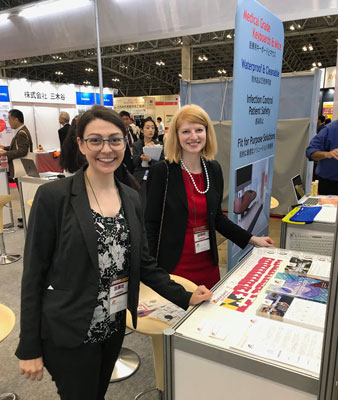Interview: Felicia Pullam, Regional Manager of East Asia, Maryland Department of Commerce
Nov 22, 2019

It is a JETRO core initiative to initiate and sustain relationships with state officials, as well as with leaders of local governments and economic development organizations who are actively working to initiate and promote further Japanese investment into their respective states and communities. It’s in this context, that JETRO New York is dedicated to maintaining relationships with key members of state governments.
JETRO NY was grateful to recently interview Felicia Pullam, Regional Manager of East Asia at the Maryland Department of Commerce. Felicia is responsible for the State of Maryland’s investment attraction initiatives, primarily with Japanese companies that are seeking business opportunities in Maryland. Felicia recently returned from a trade mission to Japan and we thought it was great timing to ask her about her role within the Maryland Department of Commerce and importantly about her recent experience from her participation in the state’s trade mission to Japan.
1.) Please describe your role with the State and a little about the State:
At the Maryland Department of Commerce, I work with Japanese businesses that are already located in Maryland or that are considering establishing operations here. We connect them with resources, link them with potential partners in the community, and serve as their local guides to doing business in the United States. In addition, I work with Maryland companies that want to enter the Japanese market.
Maryland is located next door to our nation’s capital, Washington, DC. In fact, many Japanese officials and business people who work in DC actually live in Maryland. We’re home to many federal institutions, such as the National Institutes of Health and the FDA, so we have one of the country’s top biohealth clusters. Maryland is also strong in cybersecurity, aerospace and defense, advanced manufacturing, agribusiness, and sustainability. Finally, our location in the heart of the East Coast has given us an advantage in distribution and logistics.
2.) Describe your background or history, if any, between you and Japan.
The State of Maryland has a long history of engagement with Japan. We’re very excited that this year marks the 40th anniversary of the Sister-City relationship between Baltimore and Kawasaki. In 1981, our Sister-State-Prefecture relationship was established with Kanagawa Prefecture. Both of these relationships continue to be strong to this day, and I feel very lucky to be part of them.
I like to say that I “married into Maryland,” because, while I’m not originally from here, my husband grew up just south of Baltimore. Back in 1992, he participated in the Baltimore-Kawasaki Boy Scout exchange program, and that made a big difference in his life. A few years ago, I was able to meet his host family in Kawasaki. It’s amazing to see such warm bonds that have lasted for decades.
3.) When you hear the word "Japan", what is your impression or first thought?
It’s hard not to think of food, as I’ve experienced some incredible meals in Japan. More importantly, the best meals always involve good friends, and that’s been true of my visits to Tokyo, Kawasaki, Yokohama, and Kyoto. There are so many other impressions that come to mind, so it’s hard to pick – hospitality, innovation, history, culture, and efficient, on-time, high-speed trains!
4.) Your State has more than a hundred Japanese companies. What are some advantages to bringing in more Japanese companies in the future?
Maryland is home to more Japanese companies than companies from any other country. We have a thriving Japanese community, a strategic location, a strong workforce, and a reasonable cost of living. Maryland is first among U.S. states for PhD scientists in biological sciences, mathematics, statistics, and health; first in concentration of employed doctoral scientists and engineers; and first in concentration of STEM occupations. Maryland leads the way in federal R&D obligations and R&D contract awards from the National Institutes of Health.
5.) Are there specific areas in your state that is considered a concentration of “innovation”?
As I mentioned, Maryland is very strong in biohealth, with more than 2,300 life sciences firms, including over 500 biotechnology companies. We’re also fortunate to host 78 federal labs at the National Institutes of Health, Department of Defense, Food and Drug Administration and the National Institute of Standards and Technology, among others.
We are also seeing significant innovation in cybersecurity and health IT. We have 117,000 IT workers in private industry, the National Security Agency, the U.S. Cyber Command, and other institutions. Our universities are deeply involved in training our workforce, with 16 NSA/DHS Certified Centers of Academic Excellence in Cybersecurity.
6.) Please tell us about a recent project where you worked with a Japanese company.
In September, we were excited to help cut the ribbon on Hi-Tech Color’s expansion. Hi-Tech Color is a subsidiary of Dainichiseika Color and Chemicals in Tokyo. They originally established operations in Odenton, Maryland in 1988, and they just opened a new 37,500 square foot facility to double their production capacity in the North American market.
7.) Has your governor visited Japan? Or have plans to visit Japan?
During Governor Larry Hogan’s first overseas trip in his first year as Governor of Maryland, he prioritized Japan. We were glad to follow up on that visit with a trade mission to Tokyo and Kanagawa in October this year.

Felicia at Medical Japan, a trade show in Makuhari
Messe in Chiba.
8.) You recently went on a trade mission to Japan. Can you please describe your experience?
We traveled with a delegation of seven companies to Medical Japan, a trade show in Makuhari Messe in Chiba. The traffic at the trade show was excellent, and I heard great feedback from our participating companies. We also visited Kawasaki’s Tonomachi KING Skyfront open innovation hub and the Shonan Health Innovation Park in Fujisawa, with a special stop at the Shin-Yokohama Raumen Museum. We enjoyed spending time in our sister-prefecture, and we were very impressed with the facilities and the company representatives we met.





